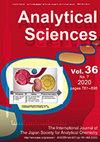Development of an HPLC device with water/acetonitrile with NaCl mixed solution that induces a phase-separation multiphase flow as the eluent in the separation column
Abstract
We developed a novel HPLC device where the phase-separation multiphase flow worked as the eluent in the separation column by using a water/acetonitrile/ethyl acetate triple mixed solution as a dual-phase-separation solution. Dual-phase-separation solutions form a phase-separation multiphase flow in a microscopic space. The new separation mechanism in the HPLC is called phase-separation mode. In this study, we used water and acetonitrile with NaCl mixed solution as a dual-phase-separation solution instead of the triple mixed solution. Octadecylsilyl (ODS)-modified particle- and porous silica particle-packed separation columns were united with the HPLC device for phase-separation mode caused by phase-separation multiphase flow. NA (1-naphthol) and NDS (2,6-naphthalenedisulfonic acid) were analyzed by the device as model sample. Using the water and acetonitrile with NaCl mixed solution at the solvent volume ratio of 5:5, NA and NDS were not separated on either column at 25 °C. On the other hand, they were separated with the order NDS and NA on the ODS column and separated with the order NA and NDS on the silica column in phase-separation mode at 0 °C. We discuss the separation mechanism of phase-separation mode using the water and acetonitrile with NaCl mixed solution at 0 °C.
Graphical abstract

 求助内容:
求助内容: 应助结果提醒方式:
应助结果提醒方式:


